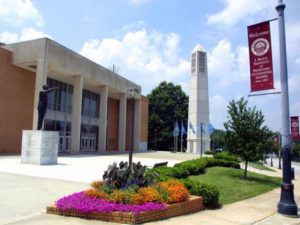
“Welcome to the Trump plantation. Overseer: Wayne A.I. Frederick” read one message. Another mimicked Kanye West’s criticism of George W. Bush: “Wayne Frederick Doesn’t Care About Black People.”
But at the time, HBCU leaders thought the executive order Trump had signed regarding Black colleges was revolutionary. The order shifted the Initiative on HBCUs from the Department of Education to the White House’s executive office with the goal of making these educational institutions more financially stable and economically empowering for students. Fast forward to August, however, and not only haven’t HBCUs received any additional funding from the federal government, but Trump also has yet to appoint an executive director for the initiative, casting doubt on his claim earlier this year that supporting HBCUs was an “absolute priority.”
Naming a leader for the initiative is “the next step in saying HBCUs are important,” Dillard University President Walter Kimbrough told Inside Higher Ed.
“I look at it as another opportunity to share the message of HBCUs as well as to have someone, in a way, lobbying for HBCUs every day within the federal government. So, I think that’s a tremendous opportunity,” he said.
The initiative dates back to President Jimmy Carter’s administration. During recent years, though, leadership has been spotty. John Sylvanus Wilson led the initiative during President Barack Obama’s first term, but since he vacated the post in 2012 to serve as Morehouse College’s president, three different people have headed the initiative.
According to a White House spokesman, the Trump administration has selected finalists for the position but hasn’t yet chosen an appointee. Leonard Haynes, executive director of the initiative during President George W. Bush’s administration, helped Trump write the executive order on HBCUs but explained that he’s not interested in leading the program again. While the Trump administration has left many appointments unfilled, it’s particularly worrisome that the Initiative on HBCUs has no leader, since the annual HBCU Week Conference takes place next month. Traditionally, the initiative oversees the event. Kimbrough said it’s important to have an executive director by September, because of the upcoming conference and also because of Trump’s strained relationship with the African-American community.
Throughout his campaign, Trump made disparaging remarks about Blacks, suggesting that African-Americans largely live in inner cities overrun with crime, despite research that shows the opposite is true. Trump, who publicly called for the execution of the Central Park Five, the group of Black and Latino teens falsely accused of beating and raping a jogger in the New York City landmark in 1989, refused to apologize when evidence vindicated them. And in January, Trump attacked U.S. Rep. John Lewis (D-Georgia), a civil rights icon, on Twitter.
“Congressman John Lewis should spend more time on fixing and helping his district, which is in horrible shape and falling apart (not to……mention crime infested) rather than falsely complaining about the election results. All talk, talk, talk — no action or results. Sad!” Trump said on the social networking site, prompting outcry even from fellow Republicans. Moreover, the fact that Trump has previously faced allegations of housing discrimination certainly doesn’t help how African-Americans perceive him.
Dillard’s Kimbrough suggests that fulfilling his promise to HBCUs can help Trump improve his relationship with Blacks.
“A really good person has to say, ‘How do I assure people in the African-American community that I am still committed to the causes of the African-American community?’ knowing that there might be some things that the president does that might be diametrically opposed to the interests of African-Americans?” he told Inside Higher Ed.
But Trump appears to be doing little to repair his relationship with the Black community or with the HBCU leaders he met with five months ago. Since meeting with the group, he’s slashed funding for grant and work-study programs upon which many HBCU students rely. He’s refused to attend events organized by civil rights groups such as the NAACP and the National Urban League. Plus, in May, he questioned whether HBCUs could legally receive aid from the federal government. That’s because Trump apparently thought HBCUs weren’t open to non-Black students and, thus, discriminatory, despite the fact that whites and non-Black students of color have attended HBCUs for years. U.S. Department of Education Secretary Betsy DeVos seems just as uninformed about HBCUs as Trump, describing them as “real pioneers when it comes to school choice,” even though they came to be because mainstream universities and colleges denied admission to Black people.
While the leaders who met with Trump in February probably don’t want to hear “I told you so” from all of the naysayers, it appears increasingly clear that the man who agreed to settle a $25 million fraud lawsuit connected to Trump University likely bamboozled them, too.
Morehouse President Wilson saw the writing on the wall months ago when Trump’s budget did not allocate additional funding to HBCUs.
“I don’t mind saying that we were — a number of us — were disappointed, not because of what we thought on our own leading up to this meeting, but what we were led to think,” Wilson said. “And so I think it was a little underwhelming to see that the most tangible differentiator that happened here was an office relocation.”


